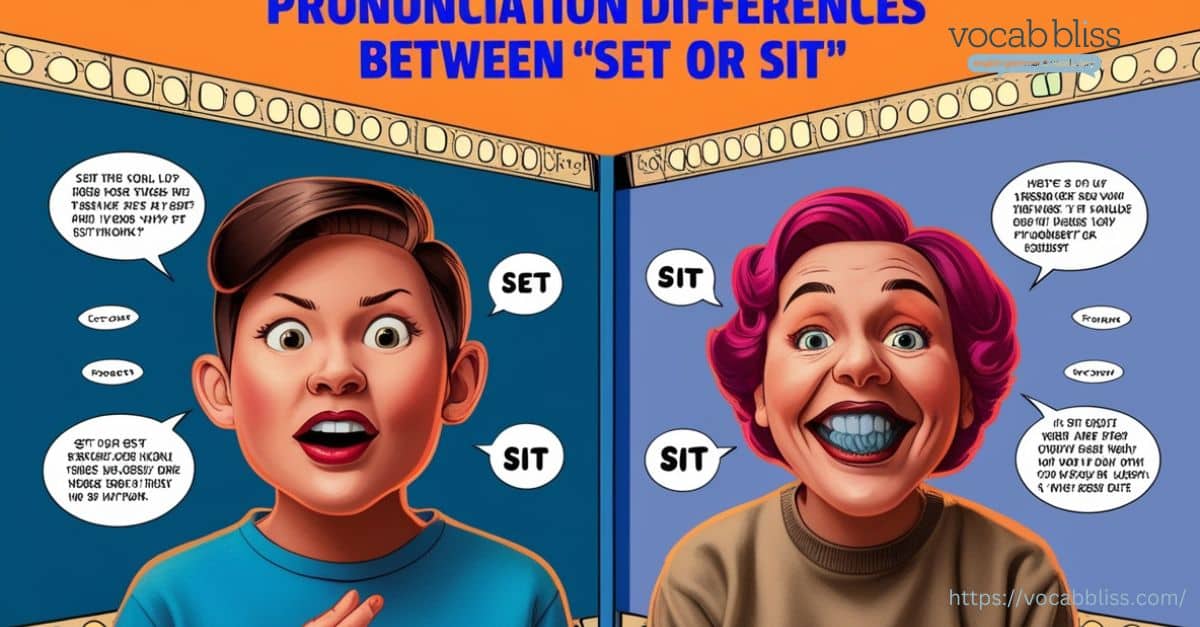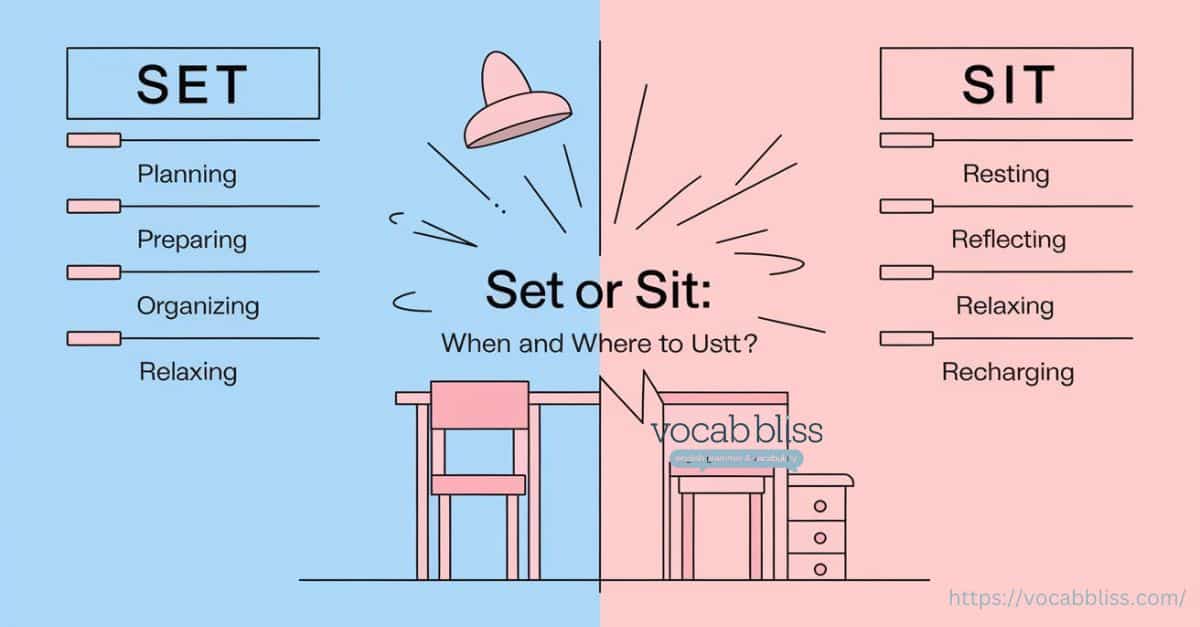Mastering English grammar involves understanding subtle differences between words. “Set or Sit” often confuse learners and even native speakers. These verbs serve unique purposes, but their correct usage hinges on context and grammatical roles. In this article, we’ll delve into their meanings, explore real-life examples, and offer practical guidance to help you confidently decide when to use “set or sit.”
Quick Summary
Understanding the difference between “set or sit” commands is essential for effective dog training. While “sit” is a straightforward command that helps maintain control, “set” guides your dog into a calm, focused state, useful in various situations like pointing or advanced training. Consistency and positive reinforcement are key to success with both commands. Rewarding your dog when they respond correctly strengthens the learning process, ensuring they understand the command’s significance. Whether you’re working with a puppy or refining skills with an older dog, mastering these commands builds better communication and strengthens your bond.
Understanding the Basics of set or sit
What Do Set or Sit Mean?
To fully grasp the differences between “sit or set,” it helps, first, to understand their meanings and, second, their grammatical roles.
- Set:
The word “set” is a transitive verb, meaning it requires a direct object. Specifically, it is used to describe the act of placing, positioning, or arranging something. In other words, it refers to the action of putting or placing something in a particular position.- Example: She set the book on the shelf.
- Sit:
The word “sit” is an intransitive verb, meaning it does not take a direct object. It refers to the action of being seated or resting in a particular position. In other words, it involves adopting or maintaining a seated position or resting somewhere.- Example: He sits by the window every evening.
Grammatical Roles
- Set: As a transitive verb, “set” always interacts with a direct object. The action of “setting” involves placing something.
- Example: Please set the plates on the table. (Plates = direct object)
- Sit: As an intransitive verb, “sit” stands alone and focuses on the subject’s position or state.
- Example: The children sit on the carpet. (No object involved)
Set in Detail
Sentence Examples Using Set
The verb “set” finds its way into various scenarios, often involving the placement of objects, the establishment of conditions, or the initiation of actions. In the following, let’s explore how it’s used in different contexts:
- Placing Objects:
- She set the vase on the table.
- The mechanic set the tools back in the drawer.
- Establishing Conditions or Rules:
- The teacher set the due date for the assignment.
- The government set new policies for environmental conservation.
- Initiating or Starting Actions:
- They set the plan in motion immediately.
- The runners set off at the sound of the whistle.
- Formal vs. Informal Usage:
- Formal: The committee set strict guidelines for the proposal process.
- Informal: Can you set the alarm for 6 AM?
When to Use the Word Set
“Set” is appropriate in sentences that involve:
- Direct Objects:
- Always ask: “Is there something being placed, arranged, or established?”
- Correct: She set the glasses on the table.
- Incorrect: She set on the couch. (This sentence should use “sat.”)
- Always ask: “Is there something being placed, arranged, or established?”
- Common Collocations:
Collocations are word pairings that frequently occur together. With “set,” some popular collocations include:- Set the table: To arrange dishes and utensils for a meal.
- Example: Can you set the table for dinner?
- Set goals: To determine objectives to achieve.
- Example: It’s important to set realistic goals for personal growth.
- Set a precedent: To establish an example for future actions.
- Example: The court’s decision set a precedent for similar cases.
- Set the table: To arrange dishes and utensils for a meal.
- Specific Actions:
- Positioning: Set the chair in the corner.
- Arranging: Set the agenda for the meeting.
- Adjusting: Set the temperature to a comfortable level.
Knowing these patterns helps ensure you’re using “set” correctly in context.
How Frequently is Set Used in English?

“Set” is one of the most versatile and frequently used words in English, primarily due to its ability to function as a noun, verb, and adjective. Furthermore, its flexibility allows it to be applied in various contexts, making it an essential part of the language.
- Verb: To place or arrange (e.g., Set the books in order).
- Noun: A collection or group (e.g., A set of keys).
- Adjective: Fixed or determined (e.g., Set schedule).
Linguistic Insights
- According to linguistic studies, “set” is among the top 200 most common English words.
- The Oxford English Dictionary identifies over 400 meanings for “set,” making it one of the most polysemous (multi-meaning) words in the language.
This versatility ensures that “set” appears in conversations, literature, and technical writing alike, thereby maintaining its relevance across contexts.
Synonyms for Set
Depending on the context, “set” can be replaced with numerous synonyms. Here’s a breakdown:
| Context | Synonyms | Example Sentence |
|---|---|---|
| Placing | Place, position, lay | She placed the flowers on the counter. |
| Arranging | Arrange, align, organize | He arranged the chairs in a circle. |
| Establishing | Define, determine, outline | The coach outlined the team’s goals for the season. |
| Adjusting | Calibrate, regulate, tweak | He regulated the thermostat to 72 degrees. |
Contextual Differences
- Place vs. Set: “Place” is more general, while “set” often implies deliberate positioning.
- She placed her bag on the table. (Neutral action)
- She set her bag on the table with care. (Deliberate emphasis)
- Arrange vs. Set: “Arrange” suggests organizing multiple items, while “set” can focus on a single item.
- They arranged the furniture to maximize space.
- He set the chair near the window.
Sit in Detail
Sentence Examples Using Sit
The verb “sit” commonly describes position, posture, or a state of resting. It also appears in several idiomatic expressions that enrich its usage. Here are some examples:
- Describing Position or Posture:
- The children sit quietly in their chairs during class.
- He likes to sit by the window and watch the rain.
- Indicating a State of Rest:
- After a long walk, they decided to sit on the park bench.
- Please sit down and relax for a moment.
- Idiomatic Expressions:
- Sit tight: Wait patiently or stay in place.
- Example: The team was told to sit tight until further instructions.
- Doesn’t sit well: Indicates discomfort or disagreement.
- Example: His decision to cancel the meeting didn’t sit well with the team.
- Sit on the fence: To remain undecided.
- Example: She’s sitting on the fence about whether to accept the offer.
- Sit tight: Wait patiently or stay in place.
These examples demonstrate how “sit” functions in both literal and figurative contexts, adapting easily to everyday conversation and expressive language.
When to Use the Word Sit
“Sit” is the correct choice when describing actions or states that involve:
- Physical Resting or Positioning:
- Use “sit” when someone or something assumes a seated or resting position.
- Correct: He sat on the couch with a cup of tea.
- Incorrect: He set on the couch with a cup of tea.
- Use “sit” when someone or something assumes a seated or resting position.
- Figurative Meanings:
- Beyond physical posture, “sit” can describe:
- A decision to wait (Sit tight until we receive an update).
- A description of comfort or fit (This chair sits perfectly in the corner).
- Beyond physical posture, “sit” can describe:
- Contextual Applications:
- Literal: The puppy sat obediently by its owner.
- Figurative: Her explanation didn’t sit well with the audience.
Understanding these nuances ensures the proper use of “sit” in various scenarios.
How Frequently is Sit Used in English?
While “sit” isn’t as versatile as “set,” it is still a frequently used verb in English due to its common applications:
- Specific Usage:
- Unlike “set,” which can serve as a verb, noun, or adjective, “sit” primarily functions as a verb.
- Corpus studies show “sit” is among the top 1,000 most frequently used English words, particularly in spoken contexts.
- Comparison to “Set”:
- “Set” is more versatile and appears in technical, formal, and idiomatic language.
- “Sit” is more specific to scenarios involving rest or posture, making its use narrower but highly relevant in everyday conversations.
Synonyms for Sit
When “sit” feels repetitive or context requires variety, several synonyms can be used. Here’s a breakdown:
| Context | Synonyms | Example Sentence |
|---|---|---|
| Resting or Seated | Rest, take a seat | Please take a seat while I prepare the documents. |
| Perched Position | Perch, roost | The bird perched on the branch, observing the area. |
| Remaining in Place | Stay, linger | The old dog lingered by the fire, enjoying its warmth. |
| Figurative Meanings | Reside, lie | The responsibility lies with the manager. |
Contextual Analysis of Alternatives
- Rest vs. Sit: “Rest” suggests relaxation, whereas “sit” focuses on the seated position.
- He rested on the bench after a long walk.
- He sat on the bench to read his book.
- Perch vs. Sit: “Perch” often implies balance or elevation.
- She perched on the edge of the chair, ready to leave.
- She sat comfortably on the chair, sipping her coffee.
Pronunciation Differences Between set or sit

Correct pronunciation is key to clear communication, especially with similar-sounding words like “sit or set“. Here’s how to distinguish between them effectively.
How to Pronounce Set
- Phonetic Breakdown:
- /sɛt/
- The vowel sound is a short “e”, similar to the sound in “bed” or “red.”
- Audio Description:
- The word begins with a sharp “s” sound, then follows with a crisp, short “e,” and ultimately ends with a soft “t.”
- Example: Say “set” as you would in set the table.
- Tips for Accurate Pronunciation:
- Focus on the short “e” sound; avoid elongating it to sound like “say-it.”
- Keep the final “t” soft but clear.
How to Pronounce Sit
- Phonetic Breakdown:
- /sɪt/
- The vowel sound is a short “i”, similar to the sound in “bit” or “hit.”
- Audio Description:
- It starts with the same sharp “s” sound as “set,” followed by a quick, clipped “i,” and then ends with a crisp “t.”
- Example: Say “sit” as in sit down.
- Tips for Accurate Pronunciation:
- Emphasize the short “i” sound; it should sound distinct from the “e” in “set.”
- Keep the “t” at the end pronounced and not swallowed.
Common Mispronunciations and Tips for Clarity
- Mixing Vowel Sounds:
- Mispronunciation: Saying “sit” with an “e” sound, making it sound like “set.”
- Solution: Practice the short “i” in “sit” by pairing it with similar words like “bit” or “lit.”
- Swallowed Endings:
- Mispronunciation: Dropping the final “t”, leading to words sounding incomplete.
- Solution: Ensure the “t” sound is audible without being overly hard.
- Regional Accents and Variations:
- In some accents, “set” and “sit” might sound closer due to vowel shifts.
- Tip: Listening to native speakers or using tools like pronunciation dictionaries (e.g., Merriam-Webster) can help refine your pronunciation.
By mastering these distinctions, you’ll confidently differentiate “Sit vs Set” in both casual conversation and formal speech.
Origins of sit or set
Historical Background of Set
The word “set” traces its origins to Old English settan, meaning “to place or cause to sit.” Over time, it evolved to include meanings such as “establish,” “adjust,” and “prepare.” Consequently, its usage expanded to reflect a broader range of actions.
Historical Background of Sit

“Sit” comes from Old English sittan, meaning “to rest in a seated position.” Its roots, in fact, stretch back to Proto-Germanic and Indo-European languages.
A Simple Tense Table for Sit or Set
| Tense | Set | Sit |
|---|---|---|
| Present | set | sit |
| Past | set | sat |
| Past Participle | set | sat |
| Present Participle | setting | sitting |
Should You Use Set vs Sit?
Key Differences
- Use “set” when an object is involved: She set the vase on the table.
- Use “sit” when no object is involved: He sits quietly in the corner.
Quick Tip
Ask yourself: “Is there an object being acted upon Sit vs Set?”
- If yes, use “set”.
- If no, use “sit”.
Examples in Context
Set in Action
- The artist set the canvas on the easel.
- We set our phones to silent during the meeting.
Sit in Action
- The children sat cross-legged on the floor.
- She sits by the fireplace every evening with a book.
Common Mistakes and How to Avoid Them
Errors When Using Set or Sit
- Incorrect: I will sit the books on the shelf.
Correct: I will set the books on the shelf. - Incorrect: He set down to rest.
Correct: He sat down to rest.
Tips to Avoid Mistakes
- Remember: “Set” requires an object; “sit” does not.
- Practice with real-life examples.
- Pay attention to the verb’s role in the sentence.
Frequently Asked Questions
When should I use set instead of sit?
Use “set” when placing or arranging something, such as Set the table for dinner.
How can I remember the difference?
Think of “set” as action-oriented (placing objects), while “sit” is stationary (resting or occupying space).
Is it sit right or set right?
Both are correct but have different meanings:
- “Sit right” refers to posture or alignment.
- “Set right” means to correct or fix something.
Final Takeaways: Mastering Set vs Sit
Mastering the commands “set or sit” can make a world of difference in your dog’s behavior. While “sit” is a basic yet powerful command for controlling your dog’s movements, “set” is all about guiding them into a relaxed, focused state, often used for activities like pointing or training. The key to success with both commands lies in consistency and positive reinforcement. Reward your dog with praise or treats when they execute the commands correctly, and practice regularly to ensure they understand the context and importance of each. Whether you’re teaching a puppy or refining an adult dog’s skills, the power of these two simple words lies in their ability to foster communication and build a strong bond between you and your dog.

